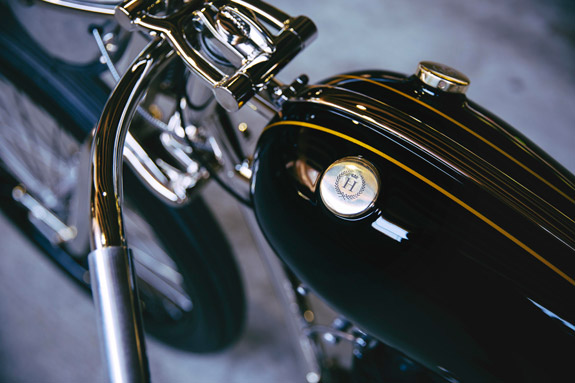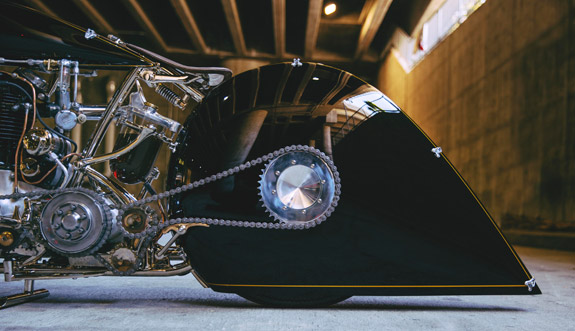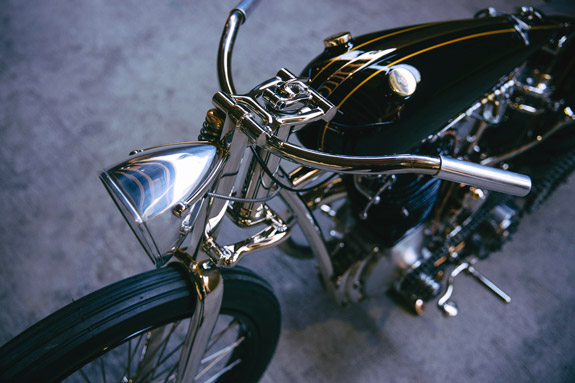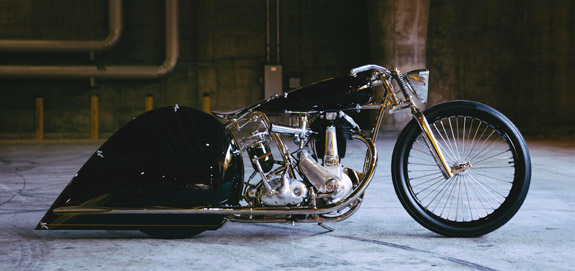Max Hazan brilliantly fabricates stunning motorcycles and motorbikes out of scrap metal
Max Hazan brilliantly fabricates stunning motorcycles and motorbikes out of scrap metal
November 2016 - Max Hazan is an atypical artist who has earned widespread praise for his ability to convert scrap metal into stylish, customized motorcycles and motorbikes. Born in 1981, Hazan spent countless childhood hours watching his father craft various items at his workshop on Long Island. Although he was “kind of born with a handy gene,” Hazan’s concentration shifted elsewhere and he earned a degree in psychology in 2005 from Tulane University in New Orleans. Roughly a week before Hurricane Katrina pounded the Gulf Coast, Hazan left the Big Easy and returned to the Northeast to settle in Brooklyn.

Back in Gotham and employed as a full-time interior designer and contractor, Hazan suffered a broken leg during a motocross mishap and was essentially confined to his couch for the next three months. While recuperating, Hazan’s focus often drifted from whatever television program he was stuck watching to a beach cruiser bicycle parked in his living room. Hazan stared at the beach cruiser and envisioned equipping it with an engine. He soon fulfilled his vision and transformed the cruiser into a motorbike.
It was epiphany, because Hazan realized his calling to become a custom builder. He rented a space in Brooklyn and established Hazan Motorworks to design, engineer, construct and sell the sizzle these elegant bikes evoked.
Around the same time, Hazan began a serious relationship. When his girlfriend accepted a job on the West Coast in 2011, Hazan reestablished his business in an 800-square-foot shop in Los Angeles. While getting acquainted with his new surroundings, Hazan met the owners of Canvas Gallery in Malibu, California. Arlington and Jacqueline Forbes were impressed with Hazan’s craftsmanship and asked if they could display one of his bikes in the gallery’s front window. Hazan gladly agreed and, almost as soon as the Forbes exhibited the bike, someone sought to purchase it.

“The Forbes helped me sell five bikes out of their gallery,” says Hazan, noting that the average price tag on one of his bikes is $75,000. “They also placed me in contact with a collector who is frequently in the market for bikes. I’m really grateful that I met them.”
Hazan, a skilled social media user with tens of thousands of followers online, doesn’t struggle to find work. With part-time assistance from neighborhood gearheads, Hazan manufactures two to three bikes annually. By using inexpensive parts, Hazan consistently makes a solid profit.
Custom craftwork
Hazan talked with FFJournal about the manual craftsmanship that went into constructing his newest venture: a 1949 BSA ZB34 (pictured above, below, and in slideshow).
Hazan bought aluminum alloy grade 6061 and other necessary raw materials for this bike at Industrial Metal Supply Co. in Burbank, California.
“Most motorcycle builders limit their sheet metal work to fenders, tanks and fairings in sections,” says Hazan. The engine and transmission were the only parts not entirely fabricated from scratch.

“The rear fender halves on this bike started as 50-in. by 40-in. sheets of 6061 aluminum. I had to anneal sections one at a time to avoid distorting the straighter sections and keep them stiff enough for when the panels were off the bike. All of the shaping was done with a shrinker and an English wheel, beginning with me laying under the sheet on a stool to reach the shrinker pedal until it started to bend up enough [so that I could] stand. A big English wheel was needed for smoothness and to calculate passes to avoid ripples and stressing the piece.”
Hazan used sheet metal air shear for rough cuts and a band saw and tube and pipe notchers for details. Hazan hid all cables and wires “tightly underneath the fender without any seams” to maintain the bike’s aesthetics.
Although the final product mirrored his original drawing, Hazan encountered issues during the fabrication process.
“Due to shrinking, I came up short working the aluminum on the fenders a couple times while developing the shape,” admits Hazan. “I also introduced some stresses in the material that would make it distort when the bike was off the frame. With an expensive paint job, this is something I couldn’t have. It had to sit perfectly on its own.”

Award winner
Since Hazan completed his final exams at Tulane more than a decade ago, he’s twice captured Pipeburn’s Bike of the Year Award and won design competitions across the globe. Despite such accomplishments, Hazan is never more excited than when he starts a new custom build. He’s now constructing a ride with a 1973 Ducati 860GT engine, Weber DCOE carburetor, Garrett GT15 compact turbocharger and “a bunch of steel, aluminum and carbon fiber.”
Hazan considers motorcycles and motorbikes to be artistic mediums and he approaches each project as if creating a “painting or sculpture.”
“I don’t believe in compromise or ego in the creative process,” says Hazan. “A piece should reflect your willingness to build whatever you can imagine. I try hard to make things I’ve never seen before and fill in the fabrication skills necessary along the way. I’ve learned 99 percent of [these] things through trial and error.”
In retrospect, motorcycle and motorbike enthusiasts worldwide are fortunate that an immobile Max Hazan kept eyeballing that beach cruiser sitting in his New York City apartment. FFJ












